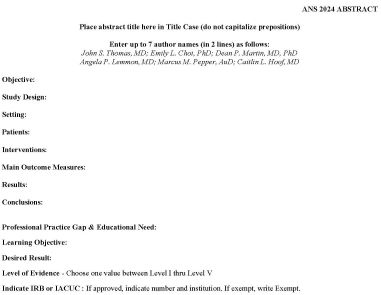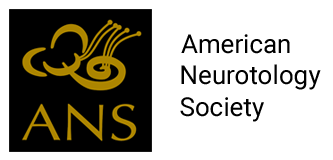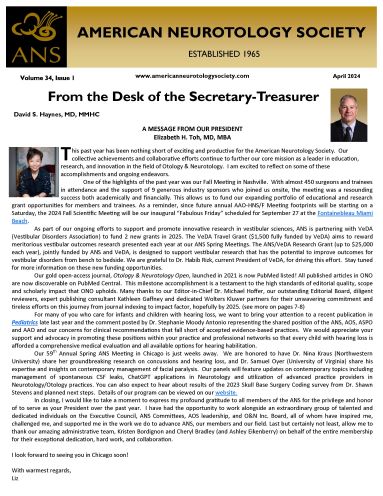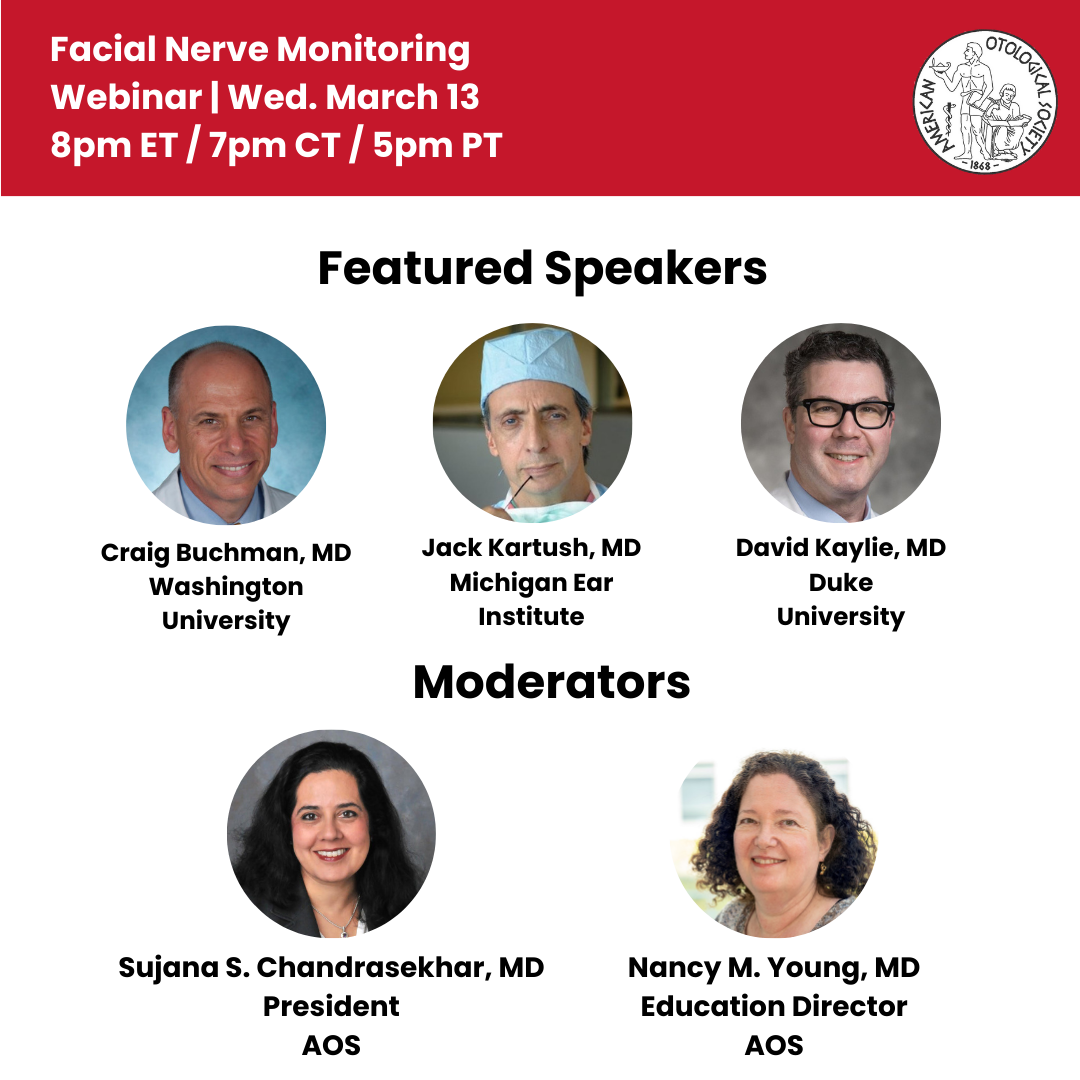ANS ABSTRACT SUBMISSION INSTRUCTIONS
AMERICAN NEUROTOLOGY SOCIETY
59th Annual Spring Meeting
Hyatt Regency Chicago
Chicago, IL
May 17-19, 2024
ABSTRACTS ACCEPTED from September 1 - October 15, 2023 (11:59 PM PT)
ABSTRACT DEADLINE is October 15, 2023 at 11:59 P.M. P.T. on Sunday night.
Be sure you start your submission before 11:59 P.T.!
The form will shut down if you are past the deadline.
Abstract Submission Instructions: VERY IMPORTANT - Please read all instructions carefully before you begin your submission. Click here to print a hard copy of the following instructions. Please contact Kristen Bordignon or Ashley Eikenberry, ANS Administrative team, if you have any questions prior to submitting your abstract. The American Neurotology Society accepts on-line submission of abstracts only. Failure to comply with the instructions will disqualify your abstract submission.
Email: [email protected]
Ph: 217-638-0801
Fax: 727-800-9428
Please note if you are not a member of the American Neurotology Society you will be required to create a username (email) and a password before you begin your abstract submission. If you created a profile in the past, use the same log in (your email address). Members may access the form when logged in.
You must indicate ONE of the following before submitting your abstract form.
- ORAL (will be considered for ORAL presentation only, a POSTER slot will not be offered as an alternative)
- POSTER
- EITHER (Selecting this category does not lessen your chances of being selected for an ORAL presentation)
The preferred method of presentation (ORAL or POSTER) should be noted. If you select EITHER, the ANS Scientific Program Committee will make the final determination as to where to place your abstract based on the final AB score. The same submission rules apply for both POSTER and ORAL submissions. The ANS abstracts are scored based on scientific merit, historically between 65-70% of abstracts are accepted. Please follow instructions to ensure you submit the best possible abstract.
Acknowledgment of receipt of an electronic abstract submission will be sent to the primary author via email from the ANS website default email, [email protected] with subject line ANS 2024 Abstract Form Submitted Successfully. If you do not receive an email acknowledgement, first check your SPAM and if it's not there, we did not receive your abstract. Please contact the ANS Administrator at [email protected] for assistance before the deadline.
IMPORTANT!!! YOUR ABSTRACT MUST BE SUBMITTED ON THE ANS ABSTRACT TEMPLATE (IN MICROSOFT OFFICE WORD, no PDF) AND ATTACHED TO THE ABSTRACT SUBMISSION FORM. CLICK HERE TO DOWNLOAD and SAVE THE WORD DOCUMENT TEMPLATE SO YOU CAN PREPARE YOUR ABSTRACT IN ADVANCE AND HAVE IT READY TO UPLOAD WHEN YOU COMPLETE THE SUBMISSION FORM.
Abstracts must be structured according to Otology & Neurotology Guidelines for Authors. Follow these guidelines when preparing your abstract.
General Format: A concise abstract of not more than 250 words or less is required for all original clinical and basic science contributions, including review articles. These should be organized according to the headings outlined below. The author(s) must accept sole responsibility for statements in their submitted abstract. The 250-word count is for the body of the abstract only, not headings or other required elements, however, the entire document is limited to one page. (see format details). The ANS Scientific Program Committee reviews all abstracts blinded to author; please do not place any identifying information in the body of the abstract or title, such as referral to authorship or institution.
Choose an appropriate title (USE OF TRADE NAMES IS PERMITTED ONLY WHEN A GENERIC TERM IS NOT AVAILABLE OR APPROPRIATE FOR THE PAPER) reflecting the content of the abstract body, as this title will appear in all publications if chosen for presentation. Do not capitalize prepositions, a, an, the, etc. Please do not enter abstract or headings in all upper case or in quotation marks. Use same format for the body of the abstract. (Times New Roman, Font size 11, "narrow margins" .5, justify where possible) Do not include the author or institution’s name(s) in the abstract title or body.
List all authors in proper sequence, with the primary/presenter FIRST (limited to seven individuals including primary author) using first names, middle initials, and last names and exact designations (i.e. MD, PhD, MS, etc. for publication purposes). We assume the primary (first) author is the presenter, however, if the primary author is not the presenter, you must name which author is the presenter at the time of submission. On the abstract form, you will also be asked to provide an email address for an additional author. If you also have a corresponding author different than the primary author, please indicate this on the abstract form. Correspondence will be sent to both the primary and the corresponding author.
MANUSCRIPTS - The American Neurotology Society requires a completed manuscript be sent electronically to the Otology & Neurotology Journal one month before the scientific program. *Only Primary authors of ORAL PRESENTATIONS must comply with the manuscript requirement. The manuscript deadline is April 19, 2024.
NEW THIS YEAR! Authors whose abstract is selected as a POSTER PRESENTATION will have the option of submitting a manuscript one month before the Annual Meeting, however, cash poster awards will only be awarded to authors submitting a manuscript to O&N by the submission deadline of April 19th.
Members of the ANS Scientific Program Committee, the ANS Education Committee or the ANS Executive Council may be asked to review the manuscript for any commercial bias, conflict of interest, use of commercial names and any other identifying information that may conflict with the ACCME requirements. ANS reserves the right to ask you to revise, modify or amend the submitted manuscript/presentation to ensure compliance with the ACCME requirements. If you fail to comply or meet the deadline, your presentation will be withdrawn from the Scientific Program. (no exceptions).
In order to complete Part I of the ANS Abstract submission process, the Primary author must complete the Conflict of Interest/Disclosure form electronically through the ANS website/SurveyMonkey® link. As the Primary author, please complete the Conflict of Interest/Disclosure form as it relates to your presentation as the primary author. If you are not the presenter, you will be asked to complete COI/DISCLOSURE information for the presenter as well. Co-authors (non-speaking roles) are NOT REQUIRED to fill out a COI/DISCLOSURE form. If you have any questions about the manner in which to do this, please contact Kristen Bordignon before you begin. All of the statements on the COI form require an answer from the primary author at the time of submission. This is an ACCME requirement.
Upon successful completion of the COI Disclosure form, you will be directly linked to the ANS website and Abstract Submission page. Be prepared to log in or create a user profile and submit your abstract at this time. YOU MAY NOT BYPASS THE COI/DISCLOSURE TO ACCESS THE ABSTRACT FORM! As the primary author, it is your responsibility to comply with the COI Disclosure guidelines.
Once you begin the abstract submission process, please be prepared to complete it in its entirety, you cannot return to an incomplete form, unfortunately, you will have to start over.
Click here or copy and paste the link below to begin the abstract submission process beginning with the mandatory Conflict of Interest/Disclosure form.
https://www.surveymonkey.com/r/ANSAbstract2024COIform
Disclosure will be stated in the scientific program and verbally from the podium via the first slide of the presentation. If you do not have anything to disclose, you must indicate this on the online form. The disclosure information you provide will not influence the review of your abstract. If your presentation describes the use of a device, product, or drug that is not FDA approved or the off-label use of an approved device, product, or drug or unapproved usage, it is your responsibility to disclose this information verbally to the learner during your presentation. The intent of this policy is not to discourage speakers who have relationships with commercial entities from presenting, but to identify these relationships to the listeners so that they may form their own judgments. Failure to disclose this information on submission forms, will result in disqualification of your abstract.
REMINDER: YOU MUST USE THE ABSTRACT TEMPLATE WHEN PREPARING YOUR ABSTRACT. THIS DOCUMENT WILL BE VIEWED AND SCORED BY THE ANS SCIENTIFIC PROGRAM COMMITTEE. LOOK FOR SPELLING & FORMATTING ERRORS BEFORE SUBMITTING. DUE TO TIME CONSTRAINTS, WE ARE NOT SWAPPING ABSTRACTS IF YOU HAVE LEFT SOMETHING OUT OR DISCOVER MISSPELLINGS.
For clinical studies:
Objective: Brief, clear statement of the main goals of the investigation.
Study design: Specify the type of study-randomized, prospective double blind; retrospective case review; etc.
Setting: Primary care vs. Tertiary referral center; ambulatory vs. hospital; etc.
Patients: Primary eligibility criteria and key demographic features.
Intervention(s): Diagnostic, therapeutic, and/or rehabilitative.
Main outcome measure(s): The most essential criterion that addresses the study’s central hypothesis.
Results: Include statistical measures where appropriate.
Conclusions: Include only those directly supported by data generated from this study.
For basic science reports:
Hypothesis: Brief, clear statement of the main goals of the investigation.
Background: Concise orientation for the reader unfamiliar with this line of investigation.
Methods: Succinct summary of techniques and materials employed.
Results: Include statistical measures where appropriate.
Conclusions: Include only those directly supported by data generated from this study. Emphasize clinical relevance wherever possible.
For reviews and meta-analysis:
Objective: Brief, clear statement of the goals of the review.
Data sources: Specify database, search methodology, languages covered, and time frame.
Study selection: Criteria used to select articles for detailed review.
Data extraction: Means of assessing quality, validity, and comparability of extracted data.
Data synthesis: Specify statistical techniques used for data analysis.
Conclusions: Concise statement of primary inferences with any recommendations.
ABSTRACT SUBMISSION FORM
The abstract form will include the following questions, please be prepared to answer each question/item. It is imperative that both the Abstract title and Primary author name is an identical match on both the Disclosure form and the Abstract Submission page. (THERE WILL BE NO CHANGES ACCEPTED AFTER 10/15/2023)
IMPORTANT! YOU WILL BE LED DIRECTLY TO THE ANS WEBSITE ABSTRACT SUBMISSION FORM UPON COMPLETION OF THE COI DISCLOSURE.
TITLE OF ABSTRACT - (USE OF TRADE NAMES IS PERMITTED ONLY WHEN A GENERIC TERM IS NOT AVAILABLE OR APPROPRIATE FOR THE PAPER) Capitalize the first letter of each word in the title, (not prepositions); please do not enter information in all upper case or in quotation marks. Use same format for the body of the abstract. Do not include the author's name(s).
AUTHORS - List all authors in proper sequence, (primary first and up to 6 more for a total of 7 max) using FIRST NAMES, MIDDLE INITIALS, and LAST NAMES AND EXACT DESIGNATIONS (i.e. MD, PhD, etc…) AS THEY WOULD BE PUBLISHED. (LIST format please, do not number or use all caps)
NAME, ADDRESS, E-MAIL OF PRIMARY AUTHOR:
NAME and E-MAIL OF PRESENTER AT COSM IF OTHER THAN THE PRIMARY AUTHOR:
INSTITUTION OR PRACTICE SETTING
ABSTRACT – YOU MUST USE THE ANS WORD DOC TEMPLATE FOR YOUR ABSTRACT AND ATTACH THE WORD DOCUMENT TO YOUR ABSTRACT SUBMISSION FORM. Save as ANS 2024 Abstract with your last name and a couple words from the title.
- The FIRST author is considered the primary AND the presenter unless otherwise indicated on the abstract form at the time of submission.
- Your word limit for the body of the abstract is 250, this does not include author, title, headings or gaps, objective, results, but the abstract must fit on ONE PAGE.
- This document is Normal Times New Roman, Font size 11, single space, narrow margins (.5), justify (align across whole page) text when at all possible.
- Save as "ANS 2024 Abstract" with your last name. If you have more than one abstract, add a digit to the end. (1,2,3, etc...)
- Your document will be viewed by the ANS Scientific Program Committee without any additional formatting, “clean-up” by the ANS administrative team. That said, be sure you follow these guidelines, check your spelling and look at past abstracts if you have any questions on HOW they should look.
- The names of the authors and the name or the IRB institution if applicable will be removed by the ANS Administrative Office as ANS abstracts are blinded but they must be included on this word document submission.
ABSTRACT EXAMPLE OF FORMATTING

IDENTIFICATION OF PROFESSIONAL PRACTICE GAPS, LEARNING OBJECTIVES, & DESIRED RESULTS ARE REQUIRED ON YOUR WORD DOCUMENT. THE DEFINITION OF EACH TERM MAY BE FOUND BELOW.
PROFESSIONAL PRACTICE GAPS are the variations or differences in the practice patterns of physicians when compared to current evidence, standards of care or clinical guidelines that are designed to provide optimum patient care.
LEARNING OBJECTIVES are short, clear statements about specific outcomes expected of the learner.
DESIRED RESULTS in terms of changes in physician knowledge, competence, performance, and/or patient outcome.
If you would like your abstract to be considered for an AWARD - on the abstract form, choose from the following:
Click on Award for details.
NEUROTOLOGY FELLOW AWARD
TRAINEE AWARD
NICHOLAS TOROK AWARD
NEW! HERBERT SILVERSTEIN AWARD FOR RESEARCH EXCELLENCE IN OTOLOGY/NEUROTOLOGY
LEVEL OF EVIDENCE - Levels of Evidence by Sackett*
(RCT = Randomized Controlled Trial)
|
Level
|
Type of evidence
|
|
I
|
Large RCTs with clear cut results
|
|
II
|
Small RCTs with unclear results
|
|
III
|
Cohort and case-control studies
|
|
IV
|
Historical cohort or case-control studies
|
|
V
|
Case series, studies with no controls
|
*Adapted from Sackett DL. Rules of evidence and clinical recommendations on the use of antithrombotic agents. Chest 1989; 95:2S–4S
Reference link: https://www.ncbi.nlm.nih.gov/pmc/articles/PMC3124652/
*For All Human and/or Animal Studies:
Indicate IRB or IACUC Approval: Approval of your studies/research must be acquired before the data is collected. Any data collected prior to IRB approval is in violation of IRB rules. IRB APPROVAL MUST BE DISCLOSED AT THE TIME OF SUBMISSION. You must enter the IRB/IACUC number and/or the name of the entity providing approval. Simply entering YES is in not acceptable. NO EXCEPTIONS. If the study has qualified as exempt from an IRB formal review, authors may state EXEMPT on the abstract submission form.
OUT of USA SUBMISSIONS: APPROVAL MUST BE OBTAINED & NOTED from the appropriate ethical entity at the time of submission. *Failure to comply will result in disqualification of your abstract.
State Yes or No if this abstract is under consideration for or denied publication and/or presented at any other Scientific meeting:
(If you have submitted your abstract to O&N, please provide the date of submission & the number linked to the submission. The O&N will be notified that this abstract is under consideration for presentation and may NOT be published until after the Scientific Program takes place or your abstract is denied).
COPYRIGHT TRANSMITTAL: Abstracts are received with the understanding that they are not under simultaneous consideration by another publication and that they are original contributions that have not been previously published. Accepted abstracts become the permanent property of Otology & Neurotology and may not be published elsewhere without permission from Otology & Neurotology*. All podium presentations accepted for the AOS and ANS Spring Meeting will be considered for publication in Otology & Neurotology through the normal peer-review process.
*On a rare occasion, submission of your manuscript to an alternative Journal may be considered. Requests will be considered individually, and no assurances of approval can be offered a priori. The intent of this exception is to allow authors to submit an abstract and present highly meritorious work to the ANS membership, yet ultimately publish the work in a journal that is deemed critical for the ongoing success of the work (e.g. compete for federal funding support).
To request this exception, at the time of submission, please send an email to the ANS Administrative Office including (1) primary author name abstract/title in word doc (2) a letter addressed to the O&N editor-in-chief, Dr. Larry Lustig, and the ANS Council explaining the reason(s) for requesting for an exception to publish in Otology & Neurotology. The request letter should include the name of the journal to which the work will be or has been submitted to and the status of that submission (submitted, under revision, accepted, or rejected). A pdf of the manuscript is required.
We do not require POSTER PRESENTERS to submit a manuscript to O&N, however we encourage you to do so. As a poster presenter, you do not have to request an exception to submit to another Journal besides O&N, but to present at ANS/AOS COSM, it cannot have been published or presented anywhere before our meeting.
PUBLICATION STATEMENT: The material in this abstract must not have been published or presented previously at another national or international meeting and may not be under consideration for presentation at another national or international meeting including another COSM society. The study detailed in this abstract may be submitted for consideration for publication to Otology & Neurotology at any time after this call for papers begins. However, should the abstract be selected as a poster or an oral presentation, publication of the manuscript will be delayed until after the 2024 COSM meeting takes place. If this policy is violated, the ANS will prohibit presentation at the COSM meeting and the manuscript will be withdrawn from publication in print or online. The penalty for any duplicate presentation/publication is prohibition of the author from presenting at a COSM society meeting for up to three years. Duplicate submission to AOS or another participating COSM Society will disqualify your abstract immediately.
Electronic signature indicates author will abide by the above Copyright and Publication statements.
The ANS Scientific Program Committee will not consider abstracts that do not contain all the required elements. In summary, please review all instructions carefully. Failure to comply with the instructions could disqualify your abstract submission. Abstracts published, presented previously or considered for presentation at another national or international meeting may not be submitted. Duplicate submissions to more than one Society will disqualify your abstract immediately.
ANS 2024 Scientific Program Committee
(in alphabetical order)
Elizabeth H. Toh, MD, MBA, ANS President, Chair
Yuri Agrawal, MD, MPH, ANS Education Director
(in alphabetical order)
Syed Ahsan, MD
Mark Bassim, MD
Gregory J. Basura, MD, PhD
Eleanor Chan, MD
Hamid Djalilian, MD
Susan D. Emmett, MD, MPH
Kenny Lin, MD
Alicia Quesnel, MD
Mallory Raymond, MD
Hamid Sajjadi, MD
Daniel Sun, MD
Alex Sweeney, MD
Courtney C.J. Voelker, MD, PhD
Peter Weber, MD, MBA
Cameron C. Wick, MD
American Neurotology Society
Administrative Office
Kristen Bordignon, Ashley Eikenberry & Cheryl Bradley
Administrative Team
5830 1st St N
St. Petersburg, FL 33703
PH: 217-638-0801
FAX: 727-800-9428
Email: [email protected]
|




